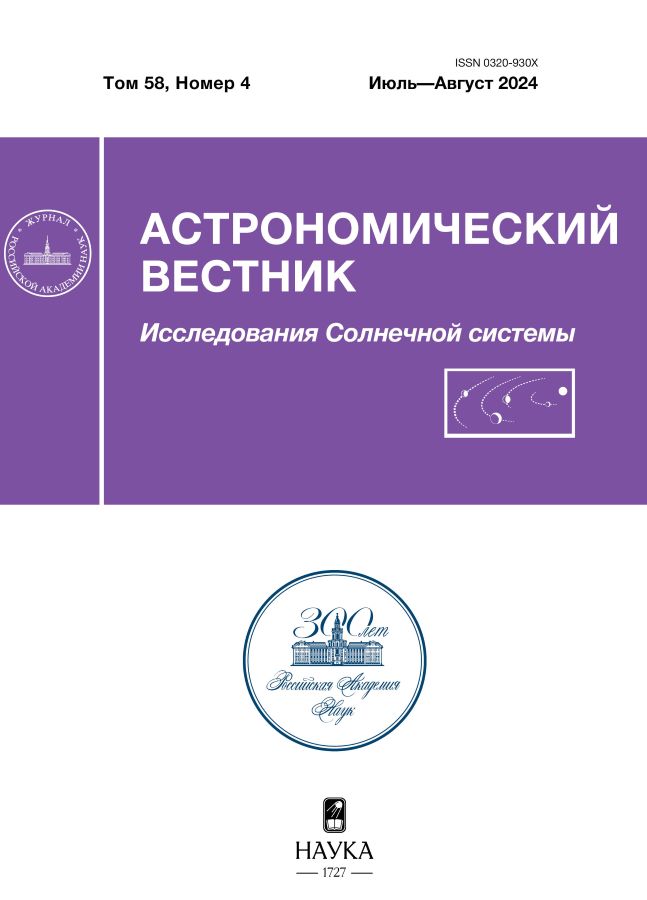Смена состава плазмы на повороте магнитопаузы Марса
- Authors: Вайсберг О.Л.1, Шестаков А.Ю.1, Журавлев Р.Н.1, Морозова Д.Н.1, Рамазан А.2
-
Affiliations:
- Институт космических исследований РАН
- Московский физико-технический институт
- Issue: Vol 58, No 4 (2024)
- Pages: 420-430
- Section: Articles
- URL: https://rjmseer.com/0320-930X/article/view/648539
- DOI: https://doi.org/10.31857/S0320930X24040063
- EDN: https://elibrary.ru/LUBDRB
- ID: 648539
Cite item
Abstract
Высокое временное разрешение измерений магнитного поля и плазмы Марса обеспечиваются наблюдениями на спутнике Mars Atmosphere and Volatile Evolution (MAVEN; Jakosky и др., 2015), позволяют анализировать тонкие слои плазменной оболочки Марса. В этой статье описана магнитная структура, связанная с дневной марсианской магнитопаузой. Было показано, что прошедший через ударную волну солнечный ветер на дневной стороне Марса напрямую не взаимодействует с ионосферой Марса. Слой плазмы и магнитного поля толщиной 200–300 км образует дневную магнитосферу, которая является областью между магнитослоем и ионосферой (Вайсберг, Шувалов, 2020). Дневная магнитосфера бывает двух типов: 1) магнитосфера более распространенного типа состоит из нагретых и ускоренных ионов O+ и O2+, находящихся между ионосферой и обтекающим горячим потоком Марса; 2) другой тип дневной магнитосферы состоит из ускоренных ионов O+ и O2+ в магнитослое, где они образуют продолжающийся ускоренный пучок, формирующий плюм. Между магнитослоем и магнитосферой находится магнитная структура, которая вращается, почти не меняя своей величины. Эта структура расположена во второй части перехода np/(np + nh) от величины ~1 до ~10–2. Переход между магнитослоем и магнитосферой происходит плавно, как по плотности энергии, так и по составу ионов при уменьшении потока протонов и увеличении потока тяжелых ионов.
Keywords
Full Text
About the authors
О. Л. Вайсберг
Институт космических исследований РАН
Author for correspondence.
Email: olegv@iki.rssu.ru
Russian Federation, Москва
А. Ю. Шестаков
Институт космических исследований РАН
Email: olegv@iki.rssu.ru
Russian Federation, Москва
Р. Н. Журавлев
Институт космических исследований РАН
Email: olegv@iki.rssu.ru
Russian Federation, Москва
Д. Н. Морозова
Институт космических исследований РАН
Email: dashia110999@mail.ru
Russian Federation, Москва
А. Рамазан
Московский физико-технический институт
Email: olegv@iki.rssu.ru
Russian Federation, Москва
References
- Вайсберг О.Л., Шувалов С.Д. Структура дневной магнитосферы Марса: два типа // Астрон. вестн. 2022. Т. 56 № 5. С. 1–12. (Vaisberg O.L., Shuvalov S.D. Structure of the Martian dayside magnetosphere: Two types // Sol. Syst. Res. 2022. V. 56. № 5. Р. 279–290.)
- Bryant D.A., Riggs S. At the edge of the Earth's magnetosphere: A survey by AMPTE-UKS // Phil. Transact. Roy. Soc. London. Ser. A. 1988. V. 328. № 1598. P. 43–56.
- Chen Y.Q., Wu M., Du A.M., Xiao S.D., Wang G.Q., Zhang T.L. A case study of the induced magnetosphere boundary at the Martian subsolar region // Astrophys. J. 2022. V. 927. P. 171.
- Dong Y., Fang X., Brain D.A., McFadden J.P., Halekas J.S., Connerney J.E., Curry M., Harada Y., Luhmann J.G., Jakosky B.M. Strong plume fluxes at Mars observed by MAVEN: An important planetary ion escape channel // Geophys. Res. Lett. 2015. V. 42. P. 8942–8950.
- Espley J.R. The Martian magnetosphere: Areas of unsettled terminology // J. Geophys. Res.: Space Physics. 2018. V. 123. P. 4521–4525.
- Fedorov A.O., Vaisberg O.L., Intriligator D.S., Sagdeev R.Z., Galeev A.A. A large amplitude
- rotational wave in the Venusian ionosheath // J. Geophys. Res.: Atmospheres. 1991. V. 96. Р. 87–99.
- Fedorov A.O., Vaisberg O.L., Intriligator D.S. A large-amplitude rotational wave in the ionosheath of Venus // Adv. Space Res. 1992. V. 12. № 8. P. 313–317.
- Hall D.S., Bryant D.A., Chaloner C.P. Plasma variations at the dayside magnetopause // Proc. 7th ESA Symp. Rockets and Balloons. 1985. P. 299–304.
- Hapgood M.A., Bryant D.A. Re-ordered electron data in tile low-latitude boundary layer // Geophys. Res. Lett. 1990. V. 17. № 11. P. 2043–2046.
- Jakosky B.M., Lin R.P., Grebowsky J.M., Luhmann J.G., Mitchell D.F., Beutelschies G., Priser T., Acuna M., Andersson L., Baird D., and 64 co-authors. The Mars Atmosphere and Volatile Evolution (MAVEN) mission // Space Sci. Rev. 2015. V. 195. P. 3–48.
- Liemohn M.W., Johnson B.C., Franz M., Barabash S. Mars Express observations of high-altitude planetary ion beams and their relation to the “energetic plume” loss channel // J. Geophys. Res.: Space Physics. 2014. V. 119. P. 9702–9713.
- Ma Y., Shu Wang, Chao Shen, Nian Ren, Tao Chen, Peng Shao, Peng E., Bogdanova Y.V., Burch J.L. Rotational discontinuities in the magnetopause of an open magnetosphere // J. Geophys. Res.: Space Physics. 2022. V. 127. № 8.
- Sonnerup B., Scheible M. Minimum and Maximum. Variance analysis magnetic in reconnection // Analysis Meth. Multi-Spacecraft Data. 1998. P. 185–220.
- Vaisberg O.L., Bogdanov A.V., Smirnov V.N., Romanov S.A. On the nature of the solar wind-Mars interaction // NASA. Goddard Space Flight Center Solar-Wind Interaction with the Planets Mercury, Venus, and Mars. 1976.
- Vaisberg O.L., Ermakov V.N., Shuvalov S.D., Zelenyi L.M., Znobishchev A.S., Dubinin E.M. Analysis of dayside magnetosphere of Mars: High mass loading case as observed on MAVEN spacecraft // Planet. and Space Sci. 2017. V. 147. P. 28–37.
Supplementary files






















